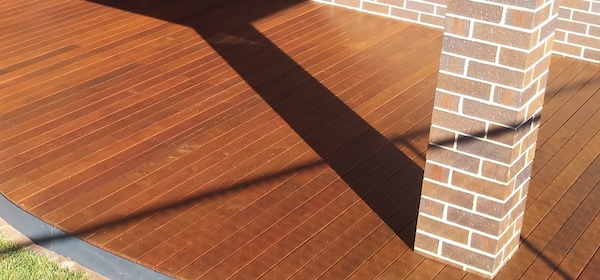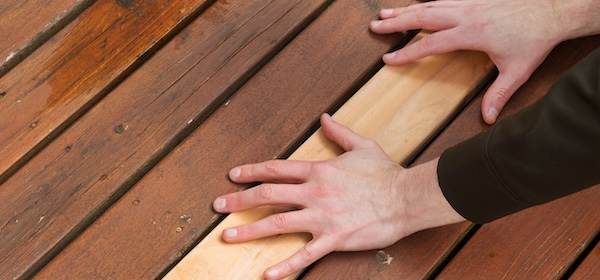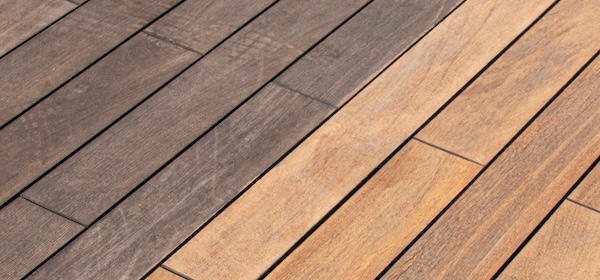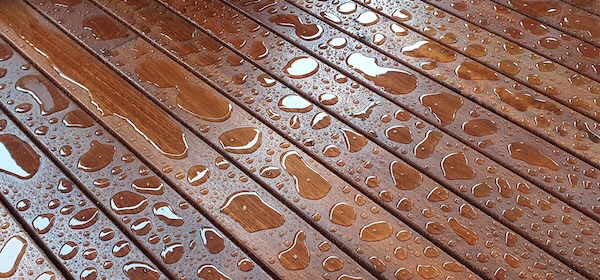Some finishes allow you to see the timber grain while others block it out completely. There are water-based, oil-based and hybrid products and then there's colour choice... We take the complexity out of choosing the right products for your deck.
The truth about sealing your deck
You want your deck to look great and last for a lifetime, but the fact is that if it’s not regularly sealed it won’t do either. Unprotected boards let moisture in and expose the surface to harmful UV which collectively lead to your timber greying, cracking and eventually rotting. When left too long boards and even structural timbers may need to be replaced.
Even when sealed professionally, decks will need a regular maintenance coat generally every 9 -18 months. This depends on the type of finish, the porosity of the timber and the amount of sun, rain and foot traffic your deck is exposed to. Maintaining and sealing your deck is fairly straightforward when done on a regular basis and is a better option than having to repair & sand it back every few years.
Deckfix ensure a no fuss professional finish using specialised techniques that protect your timber for longer. We use quality stains & oils and strict application protocols, giving you more time to enjoy your outdoor space.
FAQ’s
How do I know if my deck needs staining, oiling or coating?
Regular maintenance is the most cost-effective way to prolong the life of your deck and minimize the problems of cracking, raised grain, and mildew growth. This includes cleaning, inspecting and recoating as needed.
Generally speaking, the time between maintenance coats will normally vary between 9 & 18 months. In some cases however you may need to recoat even sooner, even when using high quality finishes. Time between maintenance coats predominantly depends on the type of finish used, the amount of weathering and the wear & tear your deck is exposed to.
1. Type of finish
Film forming finishes work by forming a thick protective layer over the timber and are designed to last longer than penetrating oils, however will normally crack, peel or flake if moisture gets in below the coating. For this reason, maintenance coats should ideally be applied while coatings are still intact but begin to look dull or change colour.
Penetrating oils protect by soaking into the timber and form minimal surface build up. As a result the surface won’t peel or flake but rather fade. This type of finish is far more forgiving as a maintenance coat simply replenishes the depleted oil within the timber and restores an even finish on the surface. Signs of the pigmentation on the surface fading indicate a maintenance coat is needed.
2. Weathering and contaminants
The amount of sun, rain and contaminants a deck is exposed to can vary greatly and so too does the time it takes for the finish to break down. These differences are clearly seen in decks that are only partially covered. The areas not exposed to weathering and contaminants last a lot longer than the exposed areas. This could leave you with a perfect finish at one end while the other end has severe fading or peeling.
If your deck has areas of high sun, rain or contaminant exposure such as pool water, it’s important that it’s recoated at the first signs of the finish breaking down in those areas. This will give you the best chance of maintaining an even colour throughout and will prolong the life of the timber.
3. Wear & tear
How often you clean your deck and the amount of wear & tear it endures are also important factors in how long your finish lasts. General foot traffic wears down your finish and when combined with dirt and debris, it can also scratch coatings. So too can dragging furniture or other heavy items. Any severe surface damage should be touched up to maximise protection and keep your deck looking good.
Can I recoat my deck using a different product?
Ideally you should always use the same product already in place when applying maintenance coats. Each product has a unique formula so manufacturers cannot guarantee compatibility with other brands. The effects of recoating with the wrong product could vary from an unsightly finish, to complete flaking if the 2 products don’t properly bond.
A change of product is usually required if you’re not happy with the performance, colour or finish of the previous product, or you simply don’t know what was last used. In any case, when changing products your existing finish should be completely removed in preparation for the new one.
What stains, oils or coatings are commonly used for timber decking?
There’s a lot to consider when choosing a new finish for your deck. This includes how you want it to look, how you intend on using it and how much maintenance it needs. The choice of available products is endless and although they each have a place in the market, we always recommend using well established, quality products with proven results.
There are transparent, semi-transparent and solid finishes and thousands of colour choices across hundreds of brands. To narrow it down, they are often categorised into 3 distinct groups.
1. Penetrating stains & oils
Quality penetrating decking finishes tend to be the preferred choice for professionals because they have an accumulative effect penetrating deep into the timber to protect it from moisture from the inside out. This helps maintain the internal structure of the timber which minimises cupping, warping and splitting. Available in transparent & semi-transparent, the addition of colour pigment in the semi-transparent provides UV protection and enhances the look of the timber without hiding its grain or natural features.
Semi-transparent finishes are mostly used for the added benefit of UV protection. As the surface layer breaks down, the pigment begins to fade away indicating that it’s time for reapplication. When a maintenance coat is applied, oil is absorbed into the areas that need it the most and an even colour is restored on the surface. Oil based products are commonly used because they are readily available and penetrate far deeper into the timber than water based penetrating stains.
2. Film forming stains
A quality film forming stain is designed to form a protective layer on the surface of the timber giving you a deep finish in a variety of colours. Available in semi-transparent & solid colours, film forming products offer a high level of UV protection when intact. Used appropriately, these stains have the ability to last longer than decking oils however they do have a downside. The finish tends to crack, peel or flake as it breaks down or sooner if any moisture gets in, making it critical to recoat at the right time to avoid having to sand away the damaged coating.
A reapplication of this type of coating is ideally done when the finish begins to look dull and a little worn to maintain a smooth even colour. Water based film forming stains are widely used because of their quick drying time and ease of clean up.
3. Decking Paint
Decking paint is commonly used to achieve a close colour match with the homes exterior and is good for covering up flaws, cracked boards and fading. Much like film forming stains they work by creating a thick coating as a seal against moisture and UV, however they are non-translucent so wont show the natural grain and colour of the wood.
Sanding and priming are generally needed when touching up or recoating as they are prone to cracking, flaking, and peeling. Maintaining a smooth uniform finish over time can be time consuming and expensive compared to other options.
How soon can I use my deck after it's been completed?
Dry times will vary for many reasons including the type of sealer used, the porosity and moisture content of the timber, as well as the weather conditions. As a general rule, our professional application processes allow most finishes to be lightly walked on within 24 hours of completion, although they shouldn’t be exposed to normal foot traffic or furniture for about 7 days.
We will advise you of how to best protect and maintain your finish, as well as the recommended wait times for your particular circumstances.






